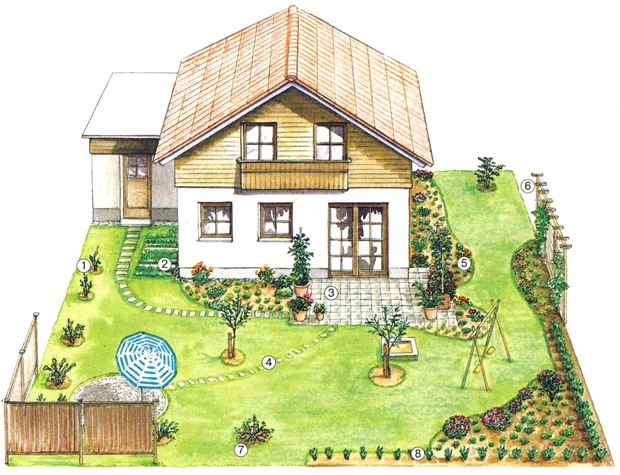When spring comes, many summer residents are wondering: what to plant on the site so that maintenance is minimal? Today, there should be no problems with the choice, since everyone can grow various crops, both flowering and fruitful, in their own plot.
In the summer, summer residents want to harvest as large a harvest of vegetables as possible in order to be filled with vitamins for the whole year, and even leave it for preservation. If we talk about tomatoes or cucumbers, then these plants require increased attention and care.
You can save water, reduce the need for chemicals, and grow a beautiful, easily fenced yard by following these steps. Where is it sunny or shady? different times of the year? Dig in several places to see if your soil is sand or clay, soggy all year round or dry bone. Look around - are there any plants with problems? How much lawn do you need or want to save?
Choose the right plant for the right place
What plantings will suit your yard? Choose plants that grow well in the northwest and match the sun, soil and water available in your yard. Check out neighborhood neighborhoods, nurseries, and demonstration gardens for plants that work well on sites similar to yours.
Choose plants that resist pests and use less water
- What about edible plants?
- Think about how big the tree or shrub will be when it's mature.

Vegetables in the country
Often it is necessary to equip greenhouses for them. But vegetables such as beets, radishes, peppers, carrots, eggplants, zucchini, pumpkin, cabbage and broccoli are quite possible to grow in the country without much effort. If you have the desire and strength, you can plant potatoes in the garden. And you can enjoy delicious and healthy melons and watermelons if you find them appropriate place at my dacha. These crops are also not picky about care, so they can produce a decent harvest with minimal watering and loosening the soil.
Choose plants that are “low water use” or “drought tolerant.” Once established, many will thrive in our limited summer rainfall for many years, saving you time and money on watering.
It is better not to plant near tomatoes
Place plants that need full sun or shade, or specific soil conditions, or frequent irrigation with those that have similar needs. This way, you don't have to water the entire yard to get to one thirsty plant!
Perennial flowers
Today there is a wide variety ornamental plants, which with minimal care give incredibly beautiful flowering. Peonies and dahlias are most often planted in the country. They reproduce by tubers. Flowering can occur in different shades, including burgundy, pink, and white.
Peony buds begin to bloom in early June. Summer residents fell in love with culture for what it gives lush flowering, while the bushes themselves are compact and beautiful. Even after the flowering period is over, the bush still fulfills its decorative qualities. It makes an excellent background for other plants. But you can see what Astra Peony Duchess mix looks like
Lawns and vegetables are picky!
They need several hours of full sun, well-drained soil levels and irrigation. Limit the areas of your lawn to where you need them. Other plants are better suited to shade, damp areas or slopes and require less maintenance. Position plants so that the soil level is at the same height on the stem as in the nursery to prevent problems. Mulch new plantings well, and be sure to water even drought-tolerant plants during their first few years until they develop deep roots. Learn more about planting and caring for trees. . You can invite birds, butterflies and other wildlife into your yard, protect shorelines and salmon, and create a more attractive landscape.
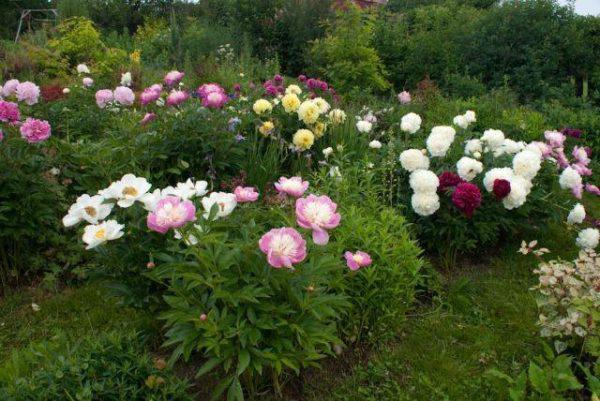
But dahlias bloom at the end of summer. It is at this time that they form numerous flowers, which can be presented in shades such as red, purple, yellow and white. Today, annual dahlias are also available; they can be used to decorate low flower beds and borders. You can see additional photos of Dahlias in the garden in the contents of this article
Grow trees and use native plants, especially with fruits and flowers. Plant in layers. Avoid using pesticides - they can poison birds, beneficial insects and salmon when rain washes them through storm drains into streams. Leave wild “buffer” areas of native plants along gullies, streams and shorelines.
Noxious Weeds - Check this list and avoid these exotic, invasive plants. Planting a few seeds on your roof or backyard produces organic, tasty results and saves money. Additionally, April is National Gardening Month. Here we show you some crops and tips on how to flower them.

Dahlias for a garden at the dacha
If you have a gazebo in your yard, then you should use clematis greens to decorate it. She will be able to perfectly decorate not only the gazebo, but also other elements on the site. This is a perennial climbing plant, which is decorated with numerous small flowers.
Adjacent to
Seasonal fruits and vegetables. Eat in a healthy, balanced and respectful environment. 
It is a red and plump perennial herbaceous plant, originating in South America, are rich in nutrients such as niacin, potassium and phosphorus, antioxidants such as lycopene, pigmentation and carotene, and vitamins A, C, etc. They can provide a luscious taste to a variety of dishes such as pasta, sandwiches and salads.
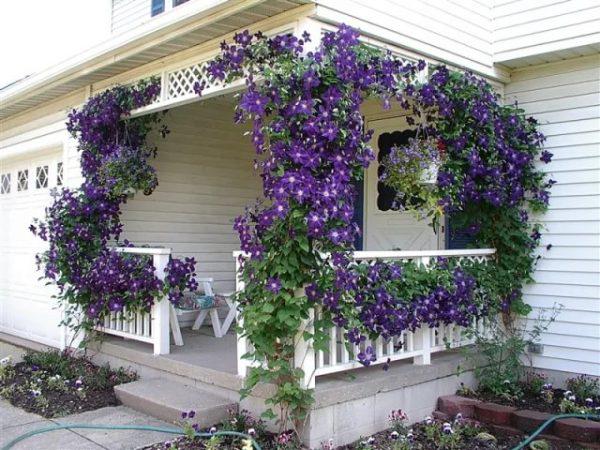
Up to 500 flower stalks can bloom on one bush. Clematis is also considered the champion in terms of flowering time among perennials. It begins to bloom in June and ends flowering in October. But here is information that will help you figure it out, which you can read by following the link.
Dig a hole for each seed, leaving at least 6 inches between seeds, cover them and press them firmly into the ground. Spray them several times a week. 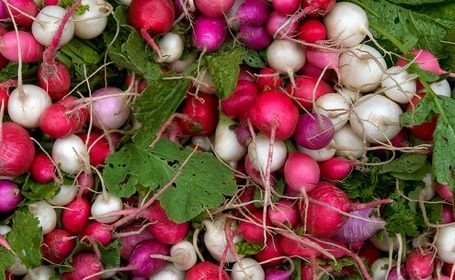
Available in red, purple and white, these tubers were first cultivated for thousands of years in Europe. They are an excellent source of potassium, folate, magnesium and calcium and are commonly used in salad sauces or as a salad dressing.
Annual flowers
If you choose annuals for your garden, then the list of plants has already increased slightly.
Marigold
This is an annual crop that is distinguished by the simplicity and beauty of its flowers. They amaze with their color range, which varies from bright burgundy to soft yellow. But the shape of the flowers can be simple or double. If you want to get tall thickets, then you should choose the African type of marigold. Their flowers are large and spherical in shape.
Water a little every other day. Radishes grow very quickly and should be ready for harvest within a few weeks. Don't wait too long or they will start to get worse. 
It is usually shaped like a cucumber. This vegetable, yellow or green color is low in calories and rich in potassium, folic acid and manganese. Zucchini can be boiled, fried or steamed as a delicious guacrinion, or stuffed and baked as a gourmet dish.
In a mound of compost 15 centimeters high and two meters wide, plant a few zucchini seeds. The space between each mound will be about two feet apart, watering deeply every day and waiting for it to germinate in a couple of weeks. They should be ready to shake a month later.

Marigold
But when is the best time to plant decorative sunflower seeds, this will help you understand
Zinnia
This is another annual plant that is not picky in its care. And although the flower has a thick stem, it still needs to be tied up. The culture has strong immunity, so it is not afraid of diseases and illnesses. Zinnia gives flowering in different color scheme except blue.
Which crops require beds and which do not?

The evolution of wild plants in the Mediterranean has a fleshy root that can be boiled and eaten, added to a salad or used in soup. Betaine, one of the key nutrients in this dark red or purple vegetable, is known to improve cardiovascular health.
Clean and strengthen the seeds by immersing them in water at room temperature On one day. Plow the soil and remove the stones from above. Seeds and water are laid every 2 centimeters at least once a day. This biennial root vegetable was domesticated primarily in the tenth century in modern-day Afghanistan. Rich in vitamin A, antioxidants and dietary fiber, carrots' orange color is the result of carotene, which is synthesized as they grow. Carrots are delicious as a healthy snack, steamed or even baked into a pie.
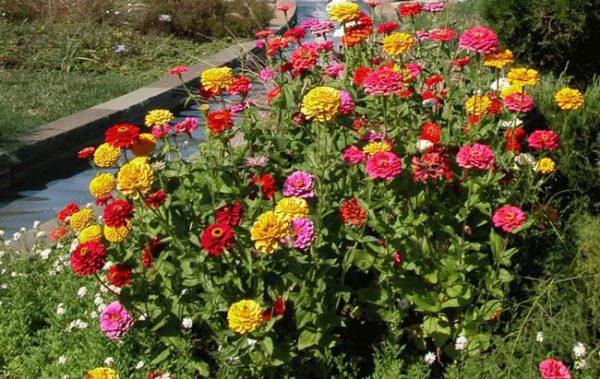
The advantage of this plant is that it loves drought. If you water the flower once a week, you are guaranteed to get abundant and lush flowering. But with regular watering, the number of flowers decreases and they become small.
Petunia
This annual flower will become wonderful decoration for any area. The plant can produce flowers of various shapes, and their bushes are compact and lush. Compared to zinnia and marigolds, petunia is less drought tolerant. If you don't have time to water it, then you shouldn't grow it. But what types of Petunia there are, you can find out by reading the contents of this
Leaving a few inches between holes, dig less than 2 inches deep and plant two seeds at a time. Make sure the soil stays moist, but remember to water less as the carrots begin to grow. 
First of all, early forms of this annual plant were discovered in ancient world on the Indian subcontinent. High level Calcium and iron, this green leafy vegetable has many benefits.
The best "neighbors" are considered
Mix the soil with compost and plant the seeds less than 2 centimeters deep, spacing them at least 5 centimeters apart to give them room to grow. 
Going back to the Neolithic era in Jordan, Syria and Turkey, they grow in a bean seed pod.
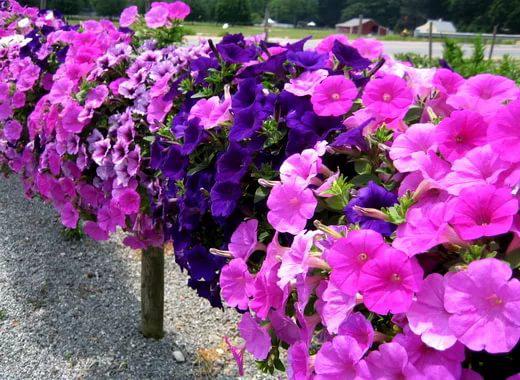
Shrubs
Summer cottages are often decorated beautiful bush. Moreover, they can be either blooming or green.
Spirea
This is an unpretentious and hardy plant. It can withstand frosts down to -30 degrees. To prolong the flowering of the shrub, it is necessary to water the crop once every 10 days. If the soil is fertile, then there is no need to fertilize. Poor soil needs to be fertilized every 3 years.
Doesn't fit well with
Nurture the soil with rich nutrients. Keep in mind that your soil must drain well for peas to bloom. Leave a few centimeters of space between each seed and sow 2 centimeters deep. Fresh frozen seeds require 1 inch of water each week, while more mature plants do.
What to plant in a small summer cottage
![]()
Native to Central and South America, these green, yellow, red or orange vegetables have flavors ranging from spicy to sweet. They contain nutrients such as thiamine, folate and manganese and can be cooked with rice and meat or in salads, sauce and pasta.
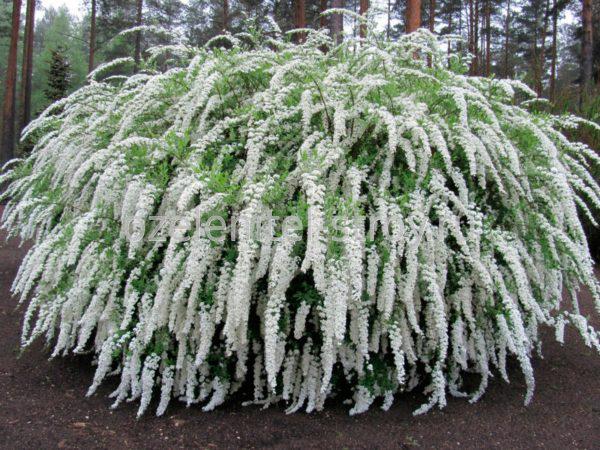
Spiraea comes in a wide variety of varieties. There are short and tall ones. The leaks can be drooping or erect. The bush blooms quite abundantly and lasts for 3 weeks. The flowers are collected in caps and have a white, yellow, or crimson tint. If you plant several varieties of spirea at your dacha, it will bloom in waves from May to July.
They grow best in hot soil, sowing seeds 15 centimeters apart. Water them often, keep the soil moist, or they may taste bitter after picking. 
Enjoying in Ancient Egypt like an aphrodisiac. As the weather warms up, it's time to evaluate the space around you to make sure it suits your goals and see where you can use feng shui to strengthen your chi and improve your positive action for better results.
Lilac
This bush begins to bloom at the end of May. The plant is frost-resistant; it is not afraid of wind and drought. It is necessary to water the bush 2 times a month. Since lilac produces a lot of shoots, it can be grown as a hedge. Single crops can form a bush or tree.

This mini feng shui guide offers 7 simple ways using outdoor feng shui - even if you live in a city or have limited control over the area outside your home or apartment. Make sure the space is clean and organized. If you live in an apartment, take a few minutes to collect all the waste from the front of your apartment building. If you have a hose, you can also wash the sidewalk.
If you live in a home with a large patio, it may take a little longer. Focus on small tasks that can be done quickly that will make a big difference. Take your children's toys and make sure they have a place to store them when not in use. Wash your sidewalk, driveway and yard. Wash your car. Tighten the hoses and hang or place in a pot a decorative spiral or other container designed to hold garden hoses.
In order for the bush to give abundant flowering every day, it is necessary to cut out the faded tops. Do this immediately after flowering, while there are no seeds on the clusters. If pruning is done later, there will be no flowering next year.
The common lilac remains very popular for the garden. Her flowers can be simple or double. But the shade is white, lilac and purple. Brushes drooping or erect. If space at your dacha allows it, you can plant Hungarian lilacs. It blooms later, but does not produce shoots, which simplifies its care. You can read about when to plant lilacs in open ground
Syringa
This plant is actively used by gardeners today. The peculiarity of the bush is that it produces snow-white flowers. You can plant several varieties on the site, so that the flowering will occur in waves from June to August.
At first, varieties with a simple flower shape begin to bloom. They have an incredible millet aroma. Then the double species bloom. The small flower covers the entire plant, making the green mass invisible. Terry inflorescences have no aroma.
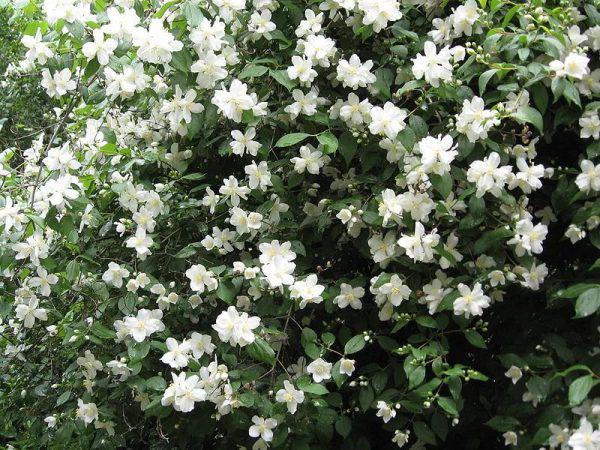
Syringa
To get abundant flowering, it is necessary to plant jasmine in a sunny area. Water during drought and prune in time. Those branches that are broken or already old should be cut off at the end of summer. Remove shrubs every 2 years. You can also fertilize using mullein infusion, wood ash or mineral fertilizers.
Hydrangea
This bush retains its decorative qualities until winter. The buds are collected in caps, and after light frosts the petals become translucent. Hydrangea needs to be grown in partial shade. If you choose a place that is too sunny, the flowers will be too small.
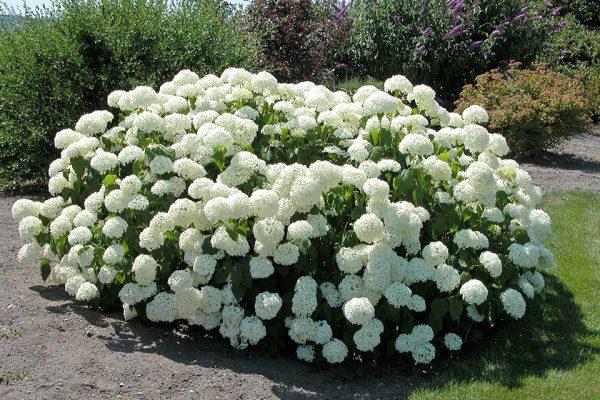
Hydrangea
Do the pruning early in the spring, when the leaves have not yet appeared. During drought, it is necessary to provide the crop with regular watering.
Trees
It is best to plant apple trees in the country. This tree does not require careful care, but still produces a lot of fruit. Thus, you can eat them not only fresh, but also make compote and jam. Once every 3 years the tree rests and does not produce fruit. You can also plant cherries at your dacha, which bear fruit every year. Apricot and peach are also considered unpretentious. But a sharply continental climate and sudden temperature changes are not suitable for them.

On summer cottage You can grow a variety of flowers and trees. The presented types of crops are unpretentious in care, and will be an excellent decoration. personal plot, and fruit trees will still allow you to enjoy delicious and healthy berries and fruits.
A well-planned garden becomes more and more beautiful over the years, and old gardens have a special charm and atmosphere.
Most plants need to grow and get stronger - the garden develops along with them, gradually turning into a blooming oasis and becoming more and more like the picture that you drew in your imagination at the very beginning.
If you want your garden to develop harmoniously, when arranging it, consider several important points.
Paths in the garden
When arranging a site, it is important to first clearly plan it, and only then lay the paths. It is important that the paths are initially designed conveniently - otherwise ugly paths will inevitably appear on the lawn, arising spontaneously in place of the most optimal routes.
It is quite possible that you should not rush with the paths, waiting until all the inhabitants of the site have laid the most convenient paths for themselves from one area of the garden to another. Then these paths can be used to create beautiful paths from tiles or natural stone.
Secluded terrace
First of all, when arranging the site, think about a place for the terrace. Usually this is a paved area next to the house.
It is a pleasant place to relax on the terrace; family dinners and friendly parties are often held here.
The terrace should become a cozy corner, so they usually try to create an atmosphere of peace and privacy. For this, green screens made from ornamental shrubs or climbing plants are used. perennial plants, which are placed on gratings and trellises.
However, these plants take time to grow. Therefore, in the first year, you can use annuals for arranging the terrace - morning glory, eccremocarpus, fire beans.
Pond
Perennial flowers
Arrange your site with flower beds with perennial flowers. Perennials are a real salvation for those who want to see their garden bloom every year, without wasting energy on planting flowers in the spring.
When planting perennials, be sure to leave gaps between the plants - after 2-3 years the plants will grow on their own and there will be no voids left in the flowerbed. Most perennials begin to bloom in the second year after planting. Choose plants such as delphiniums, phlox, geraniums.
Annual flowers
To fill empty spaces in flowerbeds where perennials have been planted, use annuals. These flowers will bloom in the first year, delighting your eyes. Looking at them, you can easily imagine how your still young garden will become a magnificent blooming corner in 2-3 years.
Vegetables
For vegetable beds you need to choose sunny places– and when choosing a location for a vegetable garden, you need to take into account the future development of the garden. Will it happen that in 3-5 years the vegetable beds will be in the shade of the trees?
You can plant any crops that suit the climate and your preferences in the beds on your site. Unlike the rest of the garden, the vegetable garden will delight you with a harvest in the first season. Just don’t forget that the crops in the beds need to be rotated every year, observing crop rotation.
Fruit trees and shrubs
Typically, fruit seedlings are purchased at the age of two, so you have to wait quite a long time for these trees to develop, bloom and produce their first harvest. For fruit trees, you need to allocate sunny areas of the garden. Apple and pear trees begin to bear fruit in 4-6 years and their yield usually increases over time.
If you don’t want to wait that long, then be sure to provide a place for planting berry bushes. They will begin to bear fruit within 2-3 years after planting.
Garden development
Are you arranging a garden and now you want to know approximately when you can expect results?
We want to show you clearly how your garden will develop. The following zones are indicated by numbers in the figures:
- Fruit trees and berry bushes.
- Garden beds.
- Terrace.
- Paths.
- Flowerbed.
- Perennial vines.
- Ornamental trees and shrubs.
- Hedge.
- Pond.
Garden in the first yearThe first results of your efforts will be noticeable already in the first year - flowering flower beds with annuals, annual vines on trellises and well-groomed vegetable beds. The rest of the garden looks a bit empty - the trees are still too small, the perennial flowers have not grown or bloomed either. |
Garden for the 3rd yearIn the third year, the garden already looks quite decorative. Perennials filled the voids in the flower beds, giving them a finished look. The trellises are entwined with perennial vines. The trees and bushes have also grown a little. In this area the playground has been replaced by small pond– the children have grown up and no longer need the sandbox, and the pond is now safe for them. |
Garden after 10 yearsAfter 10 years, the garden already appears in all its glory. If all this time it was systematically looked after and the development of plants was corrected, then perhaps the garden now looks like the originally intended option. Perennial flowers bloom in the flower beds and around the pond. Trees and shrubs bear fruit. The hedge has turned into a high green wall, protecting the garden from prying eyes. |

